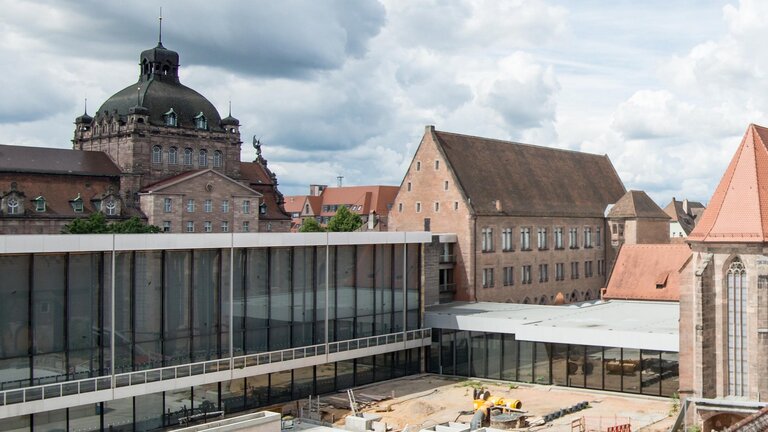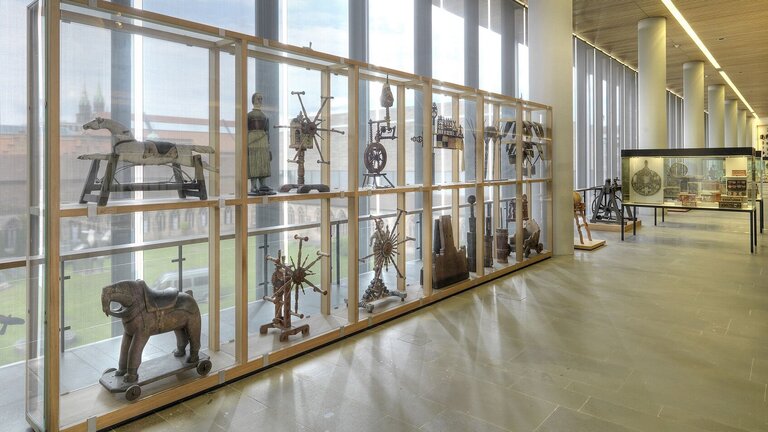Nuremberg, Germany, February 10, 2022. Outstanding sculptures, historical weapons, celestial globes and doll houses – Germanisches Nationalmuseum holds important evidence of Europe's complex history, from the Paleolithic Age through the 20th century. The museum complex is also steeped in history, as the buildings are from different eras. To ensure that the museum retains its appeal for many generations to come, two sections of the building are now being renovated. Work will be done on the landmarked south building and the southwest building, which date from around 1900 and the 1960s, as well as a staircase between them. In addition to the highly regarded architectural firm David Chipperfield Architects, Drees & Sommer SE, a consulting firm specializing in construction and real estate, is also advising on the challenging contract. The buildings are scheduled to be renovated and the exhibition spaces refurbished by the end of 2028.
Visitors can immerse themselves in the cultural history of Europe at the Germanic National Museum. And they have been doing so for more than 150 years. The largest cultural history museum in the German-speaking region was founded in 1852 by the Franconian nobleman Hans Freiherr von und zu Aufseß. The museum has continued to exert a fascination ever since.
‘Every year, several hundred thousand people visit the Germanisches Nationalmuseum out of interest. Visitors' expectations are changing, as are the technical options for exhibiting historically unique objects in a lively way while using the latest conservation techniques. Museums face the challenge of these circumstances again and again. The renovation of the south and southwest buildings is the largest and most ambitious construction project since refurbishment of the gallery building was completed in 2010. The aim is to present evidence of high and everyday culture also in the south and southwest buildings, across genres and in a historical context, thus creating a unique experience for visitors,’ explains Professor Dr. Daniel Hess, Director-General of the museum.
A Combination of Tradition and Future
The ambitious renovation project is special in many respects. The landmarked south building of the Germanic National Museum with its staircase was designed by Sep Ruf in the 1960s. The Munich-based architect is one of the most important representatives of modern architecture in Germany and Europe. The collection of musical instruments, historical clothing and folklore exhibits are spread over four floors. The exhibits place high demands on conservation. For example, the sensitive musical instruments require a special ventilation/air conditioning system.
The massive neo-Gothic southwest building was constructed around 1900 and houses the knights' hall, the farmhouse parlors and the 19th century collection. The brick building was rebuilt with slight modifications after war damage. Its historicized brick façade contrasts with the reinforced concrete structure of the Ruf building. Both sections of the building are connected by a transparent staircase.
Fit for the Next Generations
‘Renovation projects involving special-use landmarked buildings are always particularly challenging. By carrying out the renovation, all project participants are ensuring that this historic building in the middle of the city, and the art objects that it holds, will be preserved in the same quality for many generations to come,’ says Christian Marschke from Drees & Sommer, who leads the project.
The upcoming survey to establish the basis of the project will focus on examining the fabric of the building, the supporting structure, and possible contaminants present in the buildings. The project team will also develop a sustainable energy concept and review the special requirements for the design of the exhibition areas, such as the climatic conditions in the rooms, and burglar detection. ‘Renovating the exhibition rooms with energy use in mind, while also ensuring that the exhibits are properly conserved, is a highly challenging task,’ explains the project head. The project manager specializes in renovating landmarked buildings and has been involved in renovation of the Haus St. Lorenz Bible Museum and the Nuremberg Zollhof, among other projects in Nuremberg. The approval authority, the monument protection authority, the funding authority as well as the nearby residents will be involved in project planning for the Germanic National Museum at an early stage in order to ensure a smooth renovation process.
The Renovation Makes Specific Demands
The Germanic National Museum is a complex with sections of buildings from different centuries. ‘The campus around the renovation section must be considered as part of an overall structural plan, which poses an additional challenge. How can the entire complex be made accessible, for example, via the future layout of paths/roads?,’ adds Christian Matschke. The renovation of the south and southwest buildings will lay the foundation for subsequent renovations in other construction phases. ‘This makes the project highly complex.’
With the accompanying redesign of the permanent exhibition, the renovation includes rearranging the 5,500 square meter area from a technical, energy and conservation viewpoint. The total gross cost of the renovation and the exhibition facilities amounts to EUR 67 million as a preliminary cost estimate.

